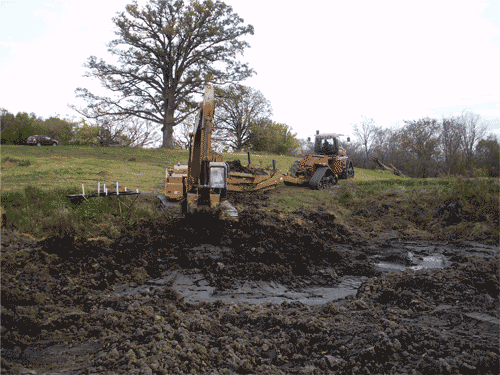Innovative ideas
MAINTAINING WATERWAYS AND RESIDUE MANAGEMENT
after years of battling soil erosion, Marion Calmer, farmer, researcher and CEO of Calmer Corn Heads, decided something needed to be done. “I guess I felt a personal need at my home farm to do a better job of controlling soil erosion,” says Calmer. “I honestly felt that I had more of an erosion problem from the lack of waterways – or waterways that weren’t in good repair – than I did from any of the hillsides or cropland acres that I had.”
About 5 years ago, rather than hire a contractor, he decided to fix them himself. Calmer invested in a pan scraper, which he pulled behind his tractor to reshape the damaged waterways. His first objective was to take the soil that had moved and put it back where it had come from. Since pan scrapers don’t normally leave the soil very flat, Calmer had to go in with a leveling device and do a little field cultivating. He finished it up with a box scraper and then made one last pass with the field cultivator.
If he were to do it the easy way, he would simply make trenches in the same direction that the water flows, but then water would end up concentrating in those low areas, immediately returning the field to an eroded state. Instead, he made his final pass in the opposite direction of the water’s natural flow, thereby hindering further soil erosion.
In his recent presentation at the Innovative Farmer’s Conference in London, Ontario, Calmer felt that most farmers were very receptive to his ideas, especially since it’s an area that many of them also struggle with. Calmer’s waterway establishment and maintenance presentation included three valuable tips.
- Don’t put anhydrous ammonia around the waterway.
- Don’t do any tillage operations around the waterway.
- Maintain the waterway by scraping out the residue in the mouth of the waterway every 2-3 years.
PHOTO: CALMER REBUILT HIS OWN WATERWAYS TO PREVENT SOIL EROSION.
 Farmers also face issues of excess residue. As the water engages with the waterway’s grass it slows down its speed and the residue or the sediment that was in the water drops out where the cropland stops and the grass waterway begins, says Calmer. Over time, the mouth of the waterway will continue to rise. Eventually, it will become high enough that the water will no longer run down the middle, but try to run around the two outsides. Every couple of years, as a preventative measure, Calmer takes his pan scraper and removes some of the residue and sediment that has accumulated. Sometimes he even uses the sediment to make repairs somewhere else in his field.
Farmers also face issues of excess residue. As the water engages with the waterway’s grass it slows down its speed and the residue or the sediment that was in the water drops out where the cropland stops and the grass waterway begins, says Calmer. Over time, the mouth of the waterway will continue to rise. Eventually, it will become high enough that the water will no longer run down the middle, but try to run around the two outsides. Every couple of years, as a preventative measure, Calmer takes his pan scraper and removes some of the residue and sediment that has accumulated. Sometimes he even uses the sediment to make repairs somewhere else in his field.
“That way the waterway is going to last for several years,” says Calmer. In fact, he says, if farmers avoid doing any tillage or applying anhydrous ammonia around the waterway (since doing so encourages water to run where you don’t want it to), the waterway should last forever.
The second part of Calmer’s presentation dealt with crop residue. Given the improved genetics of BT corn, cornstalks are now taking longer to decompose, which can create issues come planting time. There are three things you can do to accelerate decomposition, says Calmer.
First, it’s important to do a nice job of processing the cornstalk during harvest. “One of the things we developed here at our company was the BT Crusher and the BT Chopper – and those are stalk rolls that attach onto the corn heads,” says Calmer. “It does a much better job of breaking up the cornstalks so that we can allow the microbes and bacteria to get inside of the cornstalk and accelerate this decomposition process.”
Secondly, he says not to do anything that will windrow the residue so that it’s not evenly distributed on the soil surface. That happens, he says, if farmers use chopper heads, which create bare spots and other spots in the field that can be eight inches deep with residue.
Finally, he recommends doing a light tillage pass that incorporates a little bit of soil with the residue. Calmer calls it a scratch and plant system, also known as vertical tillage. “What I do here in Illinois is I scratch it in the fall and plant it in the spring,” he says.
Calmer says that those three items can almost double the decomposition rate of the residue on soil. “The advantage of that is that when I come out in the following spring that means that my soil is going to be warmer, drier and I should be able to get in and start planting a little bit sooner.”
“Not only does it allow me into the field a couple days sooner, but we also get a faster rate of growth and a healthier looking plant.”
Calmer has practiced this method for about 15 years. On average, it gets him out in the fields two days earlier. •

















